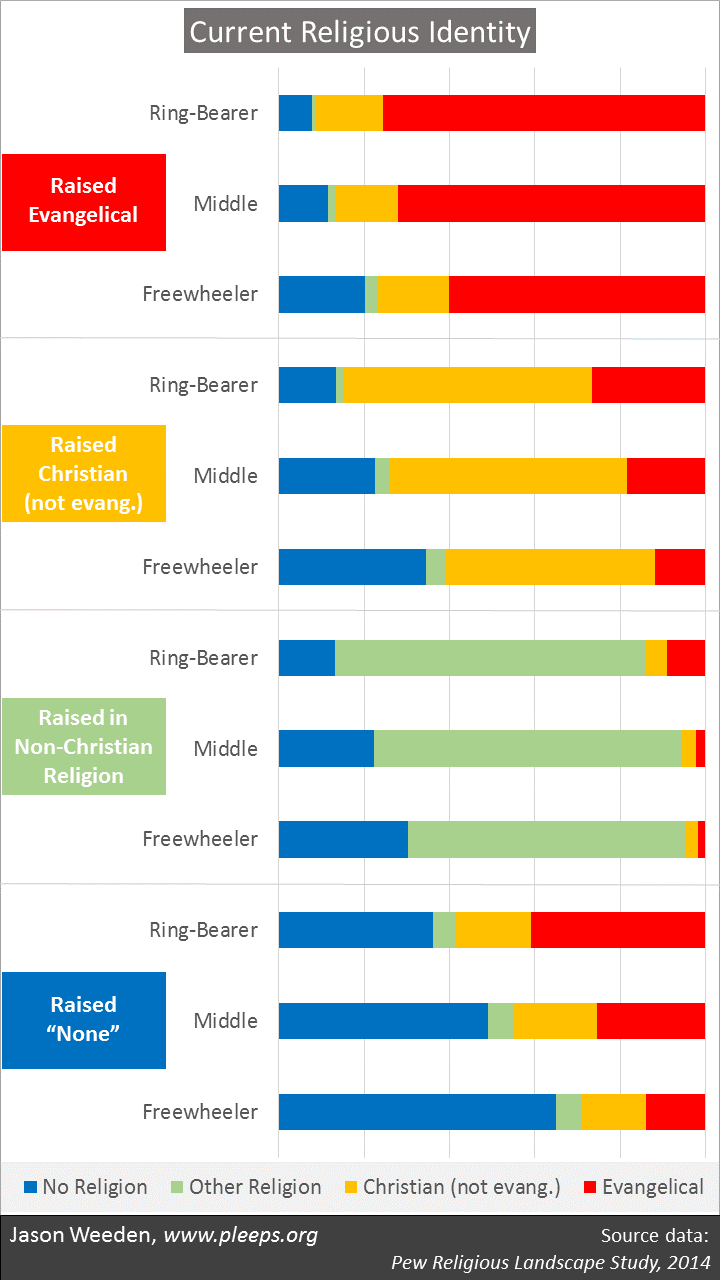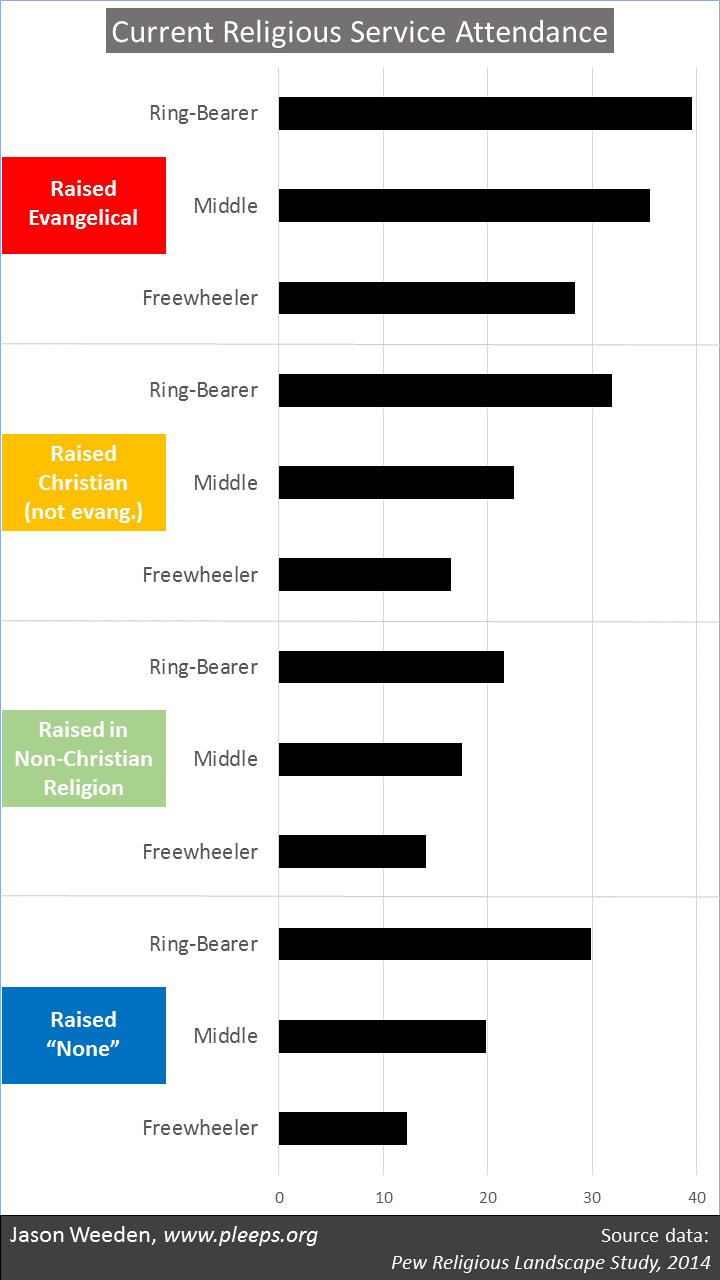If you look at the demographic predictors of ideology or party identification in the Unites States these days, the key religious divisions involve non-Christians on the left, evangelical Christians on the right, and non-evangelical Christians in the middle. In political matters, these basic religious identities further interact with other major items such as race, education, income, and gender.
How do people end up in one of these big religious camps? The usual first thought—and it’s not a bad one—is that people generally end up where they’re raised. Nonetheless, the facts here are surprisingly messy. Yes, the majority people raised in a given broad religious category end up as adults within that category, but it’s actually not a huge majority. Tons of people switch basic religious identities from childhood to adulthood.
To see what I mean, take a look at the chart below, based on data recently made public from Pew’s 2014 Religious Landscape Study, which surveyed more than 35,000 American adults. I looked at the “how were you raised?” items and the “what are you now?” items, breaking them down into (1) Christians who describe themselves as “born again or evangelical”, (2) Christians who don’t decribe themselves as “born again or evangelical,” (3) non-Christian religions (Jews, Muslims, Buddhists, Hindus, “spiritual but not religious,” etc.) and (4) the “nones” (i.e., “nothing in particular,” agnostics, atheists, and a handful of non-responders). The chart shows (weighted) percentages of the entire sample. So, for example, 23% of the sample members were raised as (self-identified) evangelicals and were also (self-identified) evangelicals at the time of the survey.
If you sum across the chart, only about 60% of the sample is in the same basic religious camp in which they were raised. In other words, when it comes to the basic politically salient religious categories, 4 in 10 adults are in a different category than their upbringing.
(Note: The religion-switching numbers I’m getting are higher than those produced by Pew, which reported only 34% switching. But we’re slicing the pie differently. I suspect that most of the difference is because I’m using the self-identified “evangelical” marker whereas I think they probably didn’t, at least not directly. I think they were more interested in denominational switching, whereas I’m focused in this post on the most politically salient distinctions, which definitely include the self-identified “evangelical” label.)
The biggest driver of religion-switching is people abandoning childhood Christianity. Around 19% of adults were raised Christian but are no longer Christian. The next-biggest deal involves shifts towards evangelicals. Around 12% of adults were not raised evangelical but are now. This is one of the basic modes of modern polarization, as the public has moved from the religious center to the leftward and rightward poles. You can see it in the basic subtotals on the chart—52.4% of the sample were raised non-evangelical Christian (the political center), but only 35.5% now hold that identity as adults. Most of that decline is picked up by “nones,” but there are also a few more evangelical adults (35%) than folks raised evangelical (33%).
One particularly striking fact is that most American “nones” were actually raised Christian. In fact, over 70% of adults who do not identify as religious grew up Christian.
Another important point is that some of these broad groups are “stickier” than others. Almost 70% of those raised evangelical are currently evangelical and the same percentage raised in non-Christian religions are currently in non-Christian religions. But non-evangelical Christians and “nones” are less “sticky”—the same-now-as-childhood portion is just a bit over half.
OK, so there’s a lot of fundamental religion-switching. But why?
Freewheelers and Ring-Bearers
One of the basic themes in my work on religion is the important connection between religiosity and people’s own sexual and reproductive lifestyles (the extent to which they engage in casual sex, marry or divorce or cohabit, have few or lots of kids, and so on). This theme then ends up linking with politics when you notice that lots of the particular issues at the heart of the divide between religious conservatives and secular liberals—abortion, birth control, gay rights, pornography, sex ed, and even marijuana legalization—are about favoring and disfavoring different sexual and reproductive lifestyles. Realizing these tangible connections opens up the possibility of viewing these “symbolic” or “cultural” religious fights as self-interest-based conflicts.
Kurzban and I have phrased people’s different lifestyles in terms of Freewheelers and Ring-Bearers. Freewheelers have more sex partners, less-committed relationships, fewer kids, and so on. Ring-Bearers are the don’t-fool-around-much, get-and-stay-married, have-lots-of-kids types. One of the key points is that these kinds of lifestyle differences aren’t just effects of one’s inherited childhood religiosity, but also important motivating causes of adopting or abandoning religion despite one’s upbringing. So, for example, lots of kids are raised religious, but then hit their teens and 20s when many (but by no means all) hear the call of the wild, and this ends up being a big reason why lots then abandon their childhood religions—those religions serve in large part as a support groups for Ring-Bearers, but when one heads down a Freewheeler path it makes less practical sense to maintain connections to religious groups.
The Pew data just barely allow a look at how lifestyle patterns factor into religion-switching. The Religious Landscape Study asked two key lifestyle questions—current marital/cohabitation status and the number of children the person has ever had. I used these two items to split the sample roughly into thirds: Freewheelers, Ring-Bearers, and those in the middle. The Freewheelers combine never-married and divorced/separated folks who’ve had 0 or 1 child as well as everyone in a non-marital cohabitation. The Ring-Bearers are never-married or divorced/separated folks who’ve had 4 or more kids, married folks with 3 or more kids, and widowed folks with 2 or more kids. The middle group is everyone else (including, e.g., married folks with 0, 1, or 2 kids).
This is a pretty low-powered way to measure Freewheelers and Ring-Bearers. Usually I’d also want to see information regarding sexual activity, whether the currently married had previously divorced, how much people drink or use recreational drugs, and so on. So, for example, there’s a big religious difference between never-married young people who don’t hook up or party much and those who do, something that I can’t detect using this Pew sample. But we can still see some basic patterns using what we’ve got.
In the chart below I’ve split things out by childhood religious category and adult lifestyle category. You can see the basic stay-where-you-were-raised tendency—those raised evangelical have lots of red in their bars (indicating current evangelical affiliation), those raised as non-evangelical Christians have lots of yellow (indicating current non-evangelical Christian affiliation), those raised in non-Christian religions have lots of green (indicating current non-Christian religious affiliation), and those raised “none” have lots of blue (indicating current “none” status).
But you can also see the lifestyle trends. In general, within each childhood camp, the Ring-Bearers have relatively more red (indicating current evangelicals) and relatively less blue (indicating current “nones”), while the Freewheelers show relatively more blue and less red. This is a sign of people aligning religion with lifestyles, as Ring-Bearers often seek out groups that support their Ring-Bearer lifestyles while Freewheelers are more likely to turn away from religions that tend to offers them more hassles than benefits.
Some items on the chart above really pop out. Look at those who were raised “none” and have a Ring-Bearer lifestyle—over 60% have adopted a religion. Look at those raised as non-evangelical Christians who have a Freewheeler lifestyle—almost 40% are no longer Christian. (Again, I should note that these kinds of patterns would be even more striking if we had a better set of lifestyle measures.)
The lifestyle patterns are even clearer when it comes to church attendance. The chart below shows average times-per-year at religious services for the Pew sample. So, for example, Ring-Bearers raised evangelical on average attend church about 40 times a year, while Freewheelers raised as “nones” attend on average only about 12. Even though we’re using a weak measure, the lifestyle differences are pretty substantial. This is especially true for those raised either non-evangelical Christian or “none” (recall that I mentioned earlier that these are the less “sticky” childhood categories). For both of these groups, the Ring-Bearers are going to church about twice as frequently as the Freewheelers. It’s also remarkable that, taking lifestyles into account, those raised non-evangelical Christian go to church only marginally more than those raised “none.”
In short, when thinking about the sources of basic religious divisions, upbringing is a big deal, but it’s not the whole story. Lots of people fundamentally change religions over their lives, often to match their lifestyles. In fact, this is a big part of the generational decline in religiosity—as lifestyles have generally shifted in a Freewheeler direction over the past several decades, religious patterns have followed suit.



